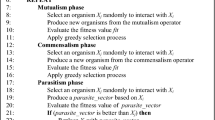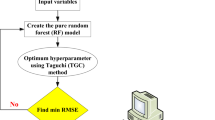Abstract
The shear strength of reinforced concrete (RC) beams is critical in the design of structural members. Developing an effective mathematical method for accurately estimating shear strength of RC beams is beneficial for civil engineers. This work presents a hybrid artificial intelligent (AI) model for effectively predicting the shear strength of various types of RC beam. The hybrid AI model was developed by integrating an optimization algorithm [smart firefly algorithm (SFA)] and machine learning [least squares support vector regression (LSSVR)], in which the SFA was used to optimize the hyperparameters of LSSVR, improving its predictive accuracy. Three large datasets were used to train and test the hybrid AI model in predicting shear strength of RC beams. The predictive accuracy of the hybrid AI model was compared comprehensively with those of single AI models, ensemble AI models, and empirical methods. The comparison results show that the hybrid AI model outperformed the others in predicting the shear strength of a wide range of RC beam types. In particular, with the test data of RC beams without stirrups, the hybrid AI model yielded a mean absolute percentage error (MAPE) of 21.703%. In predicting shear strength of RC beams with stirrups, the hybrid AI model yielded an MAPE of 12.941%. For RC beams with FRP reinforcement, the hybrid AI model yielded an MAPE 18.951%. Therefore, this hybrid AI model can be a better alternative method to help civil engineers in designing RC beams.




Similar content being viewed by others
Explore related subjects
Discover the latest articles, news and stories from top researchers in related subjects.References
ACI (2008) Building code requirements for structural concrete and commentary. ACI 318-08, Farmington Hills, MI
ACI Committee 318 (2008) Building code requirements for structural concrete and commentary (ACI 318:08). American Concrete Institute, Farmington Hills, USA
Adolfo BM, Wong KH (2003) Design of simply supported deep beams using strut-and-tie models. Struct J 100(6):704–712. https://doi.org/10.14359/12836
Atici U (2010) Prediction of the strength of mineral-addition concrete using regression analysis. Mag Concr Res 62(8):585–592. https://doi.org/10.1680/macr.2010.62.8.585
Australia S (2009) Concrete structures. AS 3600-2009, Sydney, Australia
Babar VT, Joshi PK, Shinde DN (2015) Shear strength of steel fiber reinforced concrete beam without stirrups
Boyan IM, Evan CB, Michael PC (2013) Two-parameter kinematic theory for shear behavior of beep beams. Struct J 110(3):447–456. https://doi.org/10.14359/51685602
Breiman L (1996) Bagging predictors. Mach Learn 24(2):123–140. https://doi.org/10.1023/a:1018054314350
Canadian Standards Association (CSA) (2012) Design and construction of building structures with fiber-reinforced polymers. CSA
CEN. (1992) Eurocode 2: design of concrete structures—Part 1-1: General rules and rules for buildings. EN 1992-1-1: 1992, Brussels, Belgium
CEN. (2004) Eurocode 2: design of concrete structures—Part 1-1: general rules and rules for buildings. EN 1992-1-1: 2004, Brussels, Belgium
Chabib HE, Nehdi M, Saïd A (2006) Predicting the effect of stirrups on shear strength of reinforced normal-strength concrete (NSC) and high-strength concrete (HSC) slender beams using artificial intelligence. Can J Civ Eng 33(8):933–944. https://doi.org/10.1139/l06-033
Cheng M-Y, Cao M-T (2014) Evolutionary multivariate adaptive regression splines for estimating shear strength in reinforced-concrete deep beams. Eng Appl Artif Intell 28:86–96. https://doi.org/10.1016/j.engappai.2013.11.001
Cheng M-Y, Chou J-S, Cao M-T (2017) Nature-inspired metaheuristic multivariate adaptive regression splines for predicting refrigeration system performance. Soft Comput 21(2):477–489. https://doi.org/10.1007/s00500-015-1798-y
Chou J-S, Ngo N-T (2016) Modified firefly algorithm for multidimensional optimization in structural design problems. Struct Multidiscip Optim. https://doi.org/10.1007/s00158-016-1624-x
Chou J-S, Pham A-D (2013) Enhanced artificial intelligence for ensemble approach to predicting high performance concrete compressive strength. Constr Build Mater 49:554–563. https://doi.org/10.1016/j.conbuildmat.2013.08.078
Chou J-S, Pham A-D (2015) Smart artificial firefly colony algorithm-based support vector regression for enhanced forecasting in civil engineering. Comput-Aided Civ Infrastruct Eng 30(9):715–732. https://doi.org/10.1111/mice.12121
Chou JS, Chiu CK, Farfoura M, Al-Taharwa I (2011) Optimizing the prediction accuracy of concrete compressive strength based on a comparison of data-mining techniques. J Comput Civ Eng 25(3):242–253. https://doi.org/10.1061/(ASCE)CP.1943-5487.0000088
Chou J-S, Ngo N-T, Pham A-D (2016a) Shear strength prediction in reinforced concrete deep beams using nature-inspired metaheuristic support vector regression. J Comput Civ Eng 30(1):04015002. https://doi.org/10.1061/(ASCE)CP.1943-5487.0000466
Chou J-S, Ngo N-T, Chong WK (2016b) The use of artificial intelligence combiners for modeling steel pitting risk and corrosion rate. Eng Appl Artif Intell. https://doi.org/10.1016/j.engappai.2016.09.008
Collins MP, Bentz EC, Sherwood EG (2008a) Where is shear reinforcement required? Review of research results and design procedures. ACI Struct J 105(105):590–600
Collins MP, Bentz EC, Sherwood EG (2008b) Where is shear reinforcement required? Review of research results and design procedures. ACI Struct J 105(5):590–600
CSA (2004) Design of concrete structures. Canadian Standards Association, 5060 Spectrum Way, Suite 100, Mississauga, Ontario, Canada
Cybenko G (1989) Approximation by superpositions of a sigmoidal function. Math Control Signals Syst 2:10
Danglade F, Pernot J-P, Véron P, Fine L (2017) A priori evaluation of simulation models preparation processes using artificial intelligence techniques. Comput Ind 91:45–61. https://doi.org/10.1016/j.compind.2017.06.001
El-Gamal SE, Al-Nuaimi A, Al-Saidy A, Al-Lawati A (2016) Efficiency of near surface mounted technique using fiber reinforced polymers for the flexural strengthening of RC beams. Constr Build Mater 118:52–62. https://doi.org/10.1016/j.conbuildmat.2016.04.152
Elish MO, Aljamaan H, Ahmad I (2015) Three empirical studies on predicting software maintainability using ensemble methods. Soft Comput 19(9):2511–2524. https://doi.org/10.1007/s00500-014-1576-2
Fx R (1961) Principles of neurodynamics: perceptrons and the theory of brain mechanisms. Spartan Books, Washington
Gaetano R, Raffaele V, Margherita P (2005) Reinforced concrete beep beams- shear strength model and design formula. Struct J 102(3):429–437. https://doi.org/10.14359/14414
Gandomi AH, Alavi AH, Shadmehri DM, Sahab MG (2013) An empirical model for shear capacity of RC deep beams using genetic-simulated annealing. Arch Civ Mech Eng 13(3):354–369. https://doi.org/10.1016/j.acme.2013.02.007
Hall M, Frank E, Holmes G, Pfahringer B, Reutemann P, Witten IH (2009) The WEKA data mining software: an update. SIGKDD Explor Newsl 11(1):10–18. https://doi.org/10.1145/1656274.1656278
Hastie T, Tibshirani R, Friedman J (2012) The element of statistical learning: data mining, inference, and prediction, 2nd edn. Springer, Germany
Holimchayachotikul P, Leksakul K (2017) Predictive performance measurement system for retail industry using neuro-fuzzy system based on swarm intelligence. Soft Comput 21(7):1895–1912. https://doi.org/10.1007/s00500-016-2082-5
Jain AK (2010) Data clustering: 50 years beyond K-means. Pattern Recognit Lett 31(8):651–666. https://doi.org/10.1016/j.patrec.2009.09.011
Jamil LS (2016) Data analysis based on data mining algorithms using Weka workbench. Int J Eng Sci Res Technol 5(8):262–267
Jiménez-Come MJ, Turias IJ, Trujillo FJ (2013) Pitting potential modeling using Bayesian neural networks. Electrochem Commun 35:30–33. https://doi.org/10.1016/j.elecom.2013.07.039
John CP (1998) Sequential minimal optimization: a fast algorithm for training support vector machines. Microsoft Research
Joseph RY, Shawn PG, David WD (2001) Shear strength of normal strength concrete beams reinforced with deformed GFRP bars. J Compos Constr 5(4):268–275. https://doi.org/10.1061/(ASCE)1090-0268(2001)5:4(268)
Kara IF (2011) Prediction of shear strength of FRP-reinforced concrete beams without stirrups based on genetic programming. Adv Eng Softw 42(6):295–304. https://doi.org/10.1016/j.advengsoft.2011.02.002
Kazienko P, Lughofer E, Trawinski B (2015) Editorial on the special issue “Hybrid and ensemble techniques in soft computing: recent advances and emerging trends”. Soft Comput 19(12):3353–3355. https://doi.org/10.1007/s00500-015-1916-x
Kittler J, Hatef M, Duin RPW, Matas J (1998) On combining classifiers. IEEE Trans Pattern Anal Mach Intell 20(3):226–239. https://doi.org/10.1109/34.667881
Kuncheva LI (2014) Combining pattern classifiers: methods and algorithms. Wiley, New York
Liang H, Song W (2009) Improved estimation in multiple linear regression models with measurement error and general constraint. J Multivar Anal 100(4):726–741. https://doi.org/10.1016/j.jmva.2008.08.003
Ma H, Ye S, Simon D, Fei M (2017) Conceptual and numerical comparisons of swarm intelligence optimization algorithms. Soft Comput 21(11):3081–3100. https://doi.org/10.1007/s00500-015-1993-x
Michael PC, Evan CB, Edward GS (2008) Where is shear reinforcement required? Review of research results and design procedures. Struct J 105(5):590–600. https://doi.org/10.14359/19942
Michael P, Collins ECB, Edward GS (2009) Where is shear reinforcement required? Review of research results and design procedures. Struct J. https://doi.org/10.14359/19942
Mohapatra P, Chakravarty S, Dash PK (2015) An improved cuckoo search based extreme learning machine for medical data classification. Swarm Evolut Comput 24:25–49. https://doi.org/10.1016/j.swevo.2015.05.003
Mousavi SM, Aminian P, Gandomi AH, Alavi AH, Bolandi H (2012) A new predictive model for compressive strength of HPC using gene expression programming. Adv Eng Softw 45(1):105–114. https://doi.org/10.1016/j.advengsoft.2011.09.014
Nehdi M, Chabib HE, Aly Saïd A (2007) Proposed shear design equations for FRP-reinforced concrete beams based on genetic algorithms approach. J Mater Civ Eng 19(12):1033–1042. https://doi.org/10.1061/(ASCE)0899-1561(2007)19:12(1033)
Pereira DR, Pazoti MA, Pereira LAM, Papa JP (2014) A social-spider optimization approach for support vector machines parameters tuning. In: 2014 IEEE symposium on swarm intelligence, 9–12 Dec. 2014. pp 1–6. https://doi.org/10.1109/sis.2014.7011769
Pérez JL, Cladera A, Rabuñal JR, Abella FM (2010) Optimal adjustment of EC-2 shear formulation for concrete elements without web reinforcement using genetic programming. Eng Struct 32(11):3452–3466. https://doi.org/10.1016/j.engstruct.2010.07.006
Pérez JL, Cladera A, Rabuñal JR, Martínez-Abella F (2012) Optimization of existing equations using a new Genetic Programming algorithm: application to the shear strength of reinforced concrete beams. Adv Eng Softw 50:82–96. https://doi.org/10.1016/j.advengsoft.2012.02.008
Senthilnath J, Omkar SN, Mani V (2011) Clustering using firefly algorithm: performance study. Swarm Evolut Comput 1(3):164–171. https://doi.org/10.1016/j.swevo.2011.06.003
Shrivas AK, Mishra S (2016) Application of data mining with teaching assistant evolution: a review. Int J Innov Eng Technol 7(2):8–13
Smola AJ, Schölkopf B (2004) A tutorial on support vector regression. Stat Comput 14(3):199–222. https://doi.org/10.1023/b:stco.0000035301.49549.88
Soric Z, Kisicek T, Galic J (2010) Deflections of concrete beams reinforced with FRP bars. Mater Struct 43(1):73–90. https://doi.org/10.1617/s11527-010-9600-1
Standards Australia Committee BD-002 (2009) Concrete structures. SAI Global Limited, Standards Australia, GPO Box 476, Sydney, NSW 2001, Australia
Suganyadevi MV, Babulal CK, Kalyani S (2016) Assessment of voltage stability margin by comparing various support vector regression models. Soft Comput 20(2):807–818. https://doi.org/10.1007/s00500-014-1544-x
Sun J, Li H, Adeli H (2013) Concept drift-oriented adaptive and dynamic support vector machine ensemble with time window in corporate financial risk prediction. IEEE Trans Syst Man Cybern: Syst 43(4):801–813. https://doi.org/10.1109/TSMCA.2012.2224338
Suykens JA, Gestel TV, De Brabanter J, De Moor B, Vandewalle J (2002) Least squares support vector machines. World Scientific, Singapore
Ucak K, Gunel GO (2016) An adaptive support vector regressor controller for nonlinear systems. Soft Comput 20(7):2531–2556. https://doi.org/10.1007/s00500-015-1654-0
Verikas A, Kalsyte Z, Bacauskiene M, Gelzinis A (2010) Hybrid and ensemble-based soft computing techniques in bankruptcy prediction: a survey. Soft Comput 14(9):995–1010. https://doi.org/10.1007/s00500-009-0490-5
Witten IH, Frank E (2000) Data mining: practical machine learning tools and techniques with Java implementations. Morgan Kaufmann, Los Altos
Wolpert DH (1992) Stacked generalization. Neural Netw 5(2):241–259. https://doi.org/10.1016/S0893-6080(05)80023-1
Wu X, Kumar V, Ross Quinlan J, Ghosh J, Yang Q, Motoda H, McLachlan GJ, Ng A, Liu B, Yu PS, Zhou Z-H, Steinbach M, Hand DJ, Steinberg D (2008) Top 10 algorithms in data mining. Knowl Inf Syst 14(1):1–37. https://doi.org/10.1007/s10115-007-0114-2
Yang X-S, Deb S, Fong S (2011) Accelerated particle swarm optimization and support vector machine for business optimization and applications. In: Fong S (ed) Networked digital technologies: third international conference, NDT 2011, Macau, China, July 11–13, 2011. Proceedings. Springer, Berlin, pp 53–66. https://doi.org/10.1007/978-3-642-22185-9_6
Zhang T (2013) A mechanics based approach for shear strength of RC beams without web reinforcement. Departmental Rep No R 184, Univ of Adelaide, Adelaide, Australia
Zhang T, Oehlers DJ, Visintin P (2014a) Shear strength of FRP RC beams and one-way slabs without stirrups. J Compos Constr 18(5):04014007. https://doi.org/10.1061/(ASCE)CC.1943-5614.0000469
Zhang T, Visintin P, Oehlers DJ, Griffith MC (2014b) Presliding shear failure in prestressed RC beams. I: partial-iteraction mechanism. J Struct Eng 140(10):04014069. https://doi.org/10.1061/(ASCE)ST.1943-541X.0000988
Zhang T, Visintin P, Oehlers DJ, Griffith MC (2014c) Presliding shear failure in prestressed RC beams. II: behavior. J Struct Eng 140(10):04014070. https://doi.org/10.1061/(ASCE)ST.1943-541X.0000984
Zhang T, Visintin P, Oehlers D (2016a) Shear strength of RC beams with steel stirrups. J Struct Eng 142(2):04015135. https://doi.org/10.1061/(ASCE)ST.1943-541X.0001404
Zhang T, Visintin P, Oehlers DJ (2016b) Shear strength of RC beams with steel stirrups. J Struct Eng 142(2):04015135. https://doi.org/10.1061/(ASCE)ST.1943-541X.0001404
Author information
Authors and Affiliations
Corresponding author
Ethics declarations
Conflict of interest
The authors declare that they have no conflict of interest.
Additional information
Communicated by V. Loia.
Publisher’s Note
Springer Nature remains neutral with regard to jurisdictional claims in published maps and institutional affiliations.
Rights and permissions
About this article
Cite this article
Chou, JS., Pham, TPT., Nguyen, TK. et al. Shear strength prediction of reinforced concrete beams by baseline, ensemble, and hybrid machine learning models. Soft Comput 24, 3393–3411 (2020). https://doi.org/10.1007/s00500-019-04103-2
Published:
Issue Date:
DOI: https://doi.org/10.1007/s00500-019-04103-2




